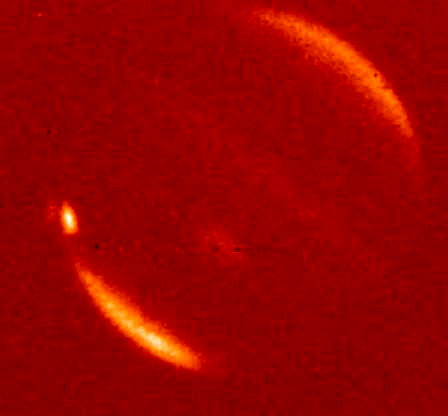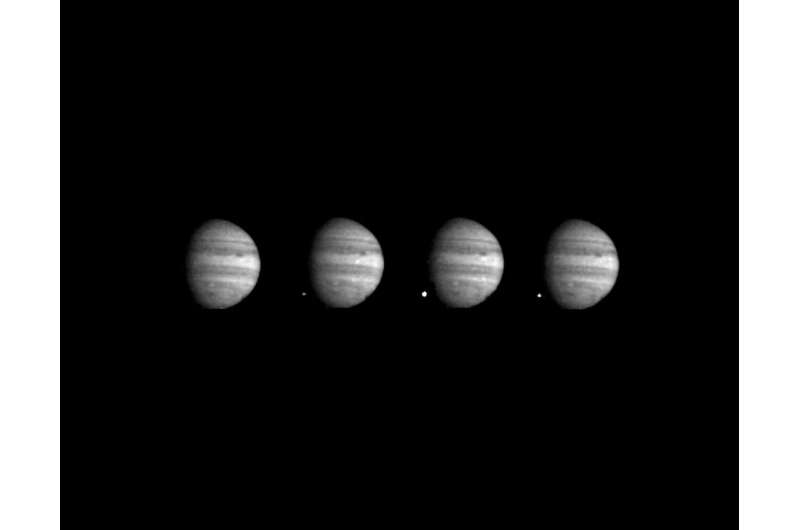How historic Jupiter comet impact led to planetary defense

Twenty-five years ago, humanity first witnessed a collision between a comet and a planet. From July 16 to 22, 1994, enormous pieces of the comet Shoemaker-Levy 9 (SL9), discovered just a year prior, crashed into Jupiter over several days, creating huge, dark scars in the planet's atmosphere and lofting superheated plumes into its stratosphere.
The SL9 impact gave scientists the opportunity to study a new celestial phenomenon. It was also a wake-up call that big collisions still occur in the solar system—after all, if Jupiter was vulnerable, maybe Earth is, too. Had the comet hit Earth instead, it could have created a global atmospheric disaster, much like the impact event that wiped out the dinosaurs 65 million years ago.
"Shoemaker-Levy 9 was a sort of punch in the gut," said Heidi Hammel, who led visible-light observations of the comet with NASA's Hubble Space Telescope and is now the executive vice president at The Association of Universities for Research in Astronomy AURA (which manages astronomers' interface to Hubble). "It really invigorated our understanding of how important it is to monitor our local neighborhood, and to understand what the potential is for impacts on Earth in the future."
Comets, cosmic snowballs of frozen gases, rock and dust that orbit the Sun, are just one type of object that can wreak havoc on planetary bodies. Asteroids—the rocky, airless remnants left over from the formation of our solar system—are another. In honor of World Asteroid Day, June 30, we look back at this historic Shoemaker-Levy 9 event, which taught us the importance of looking out for potential impacts.
Discovering the Comet
Astronomers Carolyn and Eugene Shoemaker and David Levy discovered comet SL9 in March 1993. The Shoemakers were already a well-known comet-discovering astronomical duo, having discovered 32 comets together or separately in their careers. Calculations indicated that the comet, broken up into large pieces (some over a half a mile wide) by the planet's gravity, was orbiting Jupiter and would impact in July 1994.
The news whipped the astronomical community into a frenzy—here was an opportunity to actually observe an impact. Other planets and moons are covered in craters, but we had never seen an impact happen. On Earth, scientists had recently confirmed that many of our own craters were created by impacts rather than volcanic eruptions, like the mile-wide (1.6-kilometer-wide) Meteor Crater in Arizona, and the 93-mile-wide (150-km-wide) Chicxulub Crater in the Gulf of Mexico. The SL9 impact with Jupiter would be an extraordinary opportunity to study how impacts affected a planet.
The world's astronomers had a year to prepare for the impact, so many ground-based telescopes around the world joined the campaign. This effort included NASA's Infrared Telescope Facility (IRTF) which sits atop Maunakea on Hawai'i's Big Island. NASA also ultimately received data from two of its spacecraft, the Galileo spacecraft—which was already on route to Jupiter after launching in 1989—and the Hubble Space Telescope.

"The Shoemaker-Levy 9 impacts brought together comet researchers, Jupiter atmosphere experts, and astronomers, who came together to ask "How are we going to observe this event?"" said Kelly Fast, program manager for NASA's Near Earth Object Observations Program. For the SL9 impacts, Fast was stationed at the IRTF on her first observing run. "Having that notice ahead of time to plan was really essential, because it gave us the opportunity to optimize how these observations might be made to give us the best science."
Astronomers gathered at the IRTF in Hawaii to begin preparing for the impact. The telescope, which was built in the late 1970s to support the Voyager missions to the outer planets, is sensitive to heat, so its images showed enormous bright spots where the comet fragments impacted Jupiter.
"Normally you think of the solar system as static, you don't see these big changes happen all at once," said John Rayner, director of the IRTF, who was on staff at IRTF during the impacts. "But to suddenly see these impacts, these enormous bright spots that appeared on the biggest planet in our solar system, was quite extraordinary."
As amazing as the observations were from the IRTF and numerous ground-based observatories, those telescopes from Earth didn't actually see the impacts happen because they occurred on Jupiter's "night" side. Only as the planet rotated did ground-based telescopes get to see the after-effects of the impact.
But NASA's Galileo spacecraft had a front-row seat for the event. At the time of the impacts, Galileo was on its way to study Jupiter and its moons, and approaching at the right geometry to witness the fragments of SL9 slam into the gas giant. From 238 million kilometers (148 million miles) away, the spacecraft started snapping photos.
The best images, though, came from Hubble, which had recently gotten crucial repairs in its first servicing mission. Above Earth's atmosphere, with its high-resolution camera, Hubble's exquisite image quality allowed scientists to track the plumes growing and collapsing onto the cloud tops of Jupiter. Slowly, as the planet rotated, dark scars were revealed in its atmosphere where the comet fragments had impacted. Astronomers saw expanding waves of dark material, the shapes of the plumes, and details in the explosions' debris fields with unparalleled detail. Hubble press conferences were held at least once a day for the full week so that the public could follow along as new images came in.
Hammel recalls being initially skeptical that Hubble would see anything at all, since the comet was so small compared to the immense gaseous planet. When the images started coming down, she barely slept for days.
"I was astonished, and then I was elated," she said. It was just so remarkable to be involved in a project I knew was going to change our understanding of Jupiter, and change our understanding of impacts in the Solar System."

Impact Science
Scientists around the world observed the aftermath of the 21 fragments that slammed into Jupiter's atmosphere. Each impact lofted material that splashed back into Jupiter's atmosphere, creating debris that acted as markers for scientists on Earth to study Jupiter's winds. Before the event, cloud tracking was the primary way to see how the gas giant's atmosphere transported material around the planet. But material like ammonia and hydrogen cyanide lofted into the stratosphere from deep under Jupiter's uppermost clouds gave scientists a way to track the winds as those molecules were blown around the planet. Even today, scientists can still detect the changes in hydrogen cyanide in Jupiter's atmosphere from the impacts.
Observations were also able to refine basic impact models and tell us more, in general, about how particles are transported around an atmosphere after an impact. Because we can't test impacts in real life—except at very small scales, like shooting a pebble into a block of rock in a laboratory—the SL9 impacts offered scientists a natural experiment with which to study how massive impacts affect a large body like a planet. Studying SL9's impact on Jupiter helped scientists strengthen their models of what might happen if a comet or asteroid struck Earth.
A Wake up Call for Humanity
Before the SL9 impact, the term "planetary defense" didn't exist. These days, there are many teams of scientists tracking near-Earth objects (NEOs): asteroids that come within 30 million miles (50 million kilometers) of Earth's orbit. But back in the mid 1990s, only a few teams (including the Shoemakers) were looking for asteroids in the inner solar system.
In the year before the impact, a study team in the Air Force led by Lindley Johnson, now NASA's first (and so far, only) Planetary Defense Officer, had been trying to convince their leadership that finding and tracking NEOs should be a part of the Air Force's space situational awareness mission. When SL9 was found to be on a collision course with Jupiter, Johnson's research became a major element in the Air Force's study of future space capabilities.
By 1998, Congress—influenced by Eugene Shoemaker and other scientists advocating for NEO research and with Hubble images of Jupiter's devastation fresh in their minds—officially directed NASA to find 90% of the asteroids in our celestial neighborhood 1 kilometer or larger. By the end of 2010, NASA had achieved that goal. Now, the agency is working to identify at least 90% of the asteroids between 450-3,000 feet (140-1,000 meters) wide, and they're about a third of the way there.
"The Shoemaker-Levy 9 event showed us that we are vulnerable to impacts in the present day, not just in the distant past," said Johnson. "These impact events occur in the Solar System right now, and we should do our best to find hazardous objects before they are of imminent danger of impacting Earth."
Provided by NASA's Goddard Space Flight Center





















